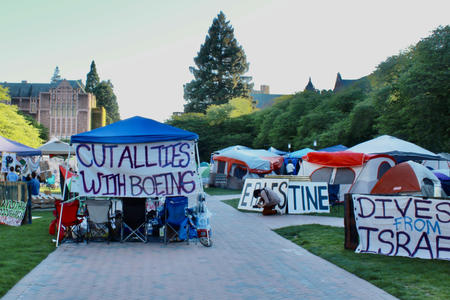How did humans come to the Pacific Northwest? The old theory was that folks migrated from Siberia across an Aleutian land bridge. It was thought those people moved south through a gap between massive ice sheets near the Rocky Mountains at a time glaciers covered much of northern North America, including our region.
But it looks like people were here well before that gap existed. Many researchers now believe they first came by sea, following the coastline from north to south.
About 10 years ago, property owners on Orcas Island were digging a new pond on their property, when workers uncovered some old bones. The bones didn’t reflect the fauna that live on the islands today — they were the remains of massive prehistoric bison — bison antiquus.
But they found some other things that made the bones an extremely interesting find. They showed signs of human contact.
Upon close examination, the researchers found signs of butchering. No tools or spearpoints were found at Ayer Pond, but these bones had fractures, scrapes and concussion marks indicative of human activity — perhaps meal preparation.
We know that these early peoples had the tools to leave such marks. Also, the main carcass of the animal seems to have been removed to another location. That wouldn’t have been easy. Such critters were much bigger than the buffalo that chase foolish tourists at Yellowstone National Park today. These could grow 7½ feet tall and weigh 3,500 pounds.
The bones also turned out to be very old — about 14,000 years old. That makes the Ayer Pond discovery the earliest physical evidence of human activity in the Salish Sea basin, according to a recent survey of Salish Sea archaeology. And here’s another eye-opening thing: They are among the earliest evidence of coastal human migration on the West Coast.
As the ice retreated because of a warming climate, the landscape changed. The area around Ayer Pond would have been a tundra-like meadow with lodgepole pines in a parkland-type setting. The fact massive bison were here suggests that there was some kind of link to the mainland.
The Salish Sea was brand new at that time, carved out and flooded only a thousand or so years before. The sea was shallower and much of the coastline of that era is now underwater because the melting ice eventually raised the sea level. Gaps between land were less than today. Ice bridges, swimmable channels or direct connections could explain how the buffalo, ground sloths and other large mammals roamed the islands.
Bison remains have been found on Vancouver Island, too. Eventually, the animals were stranded by surrounding water. At the same time, across the Strait of Juan de Fuca on Washington’s Olympic Peninsula, mastodons, caribou and bison browsed the flora that followed the glacial retreat. In the 1970s, a mastodon bone with a bone spear in it was found near Sequim. This so-called Manis Mastodon fell to hunters only a little while after the Ayer Pond bison is thought to have been butchered.
The ancient bison that fed early inhabitants went extinct about 10,000 years ago, victims with other prehistoric megafauna of the Pleistocene Era because of climate change and overhunting by humans, it is believed.
The San Juan Islands still attract people for camping and cookouts. But who knew that grass-fed, organic, free range buffalo was an early item on the prehistoric menu for the first-comers? That fact has given us an important peek into our region’s early human origins.




